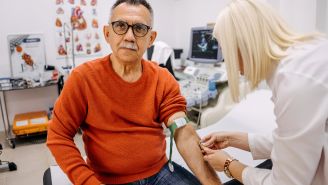Updated on March 27, 2024.
Acute myeloid leukemia (AML) is the most common form of leukemia in adults. Leukemias are a type of cancer that begin in the bone marrow, with the formation of cancerous blood cells. Leukemias can be described as acute or chronic depending on how quickly they grow and progress. Acute leukemias grow and progress quickly—and it’s recommended to begin treatment as soon as possible.
Initial treatment of AML
Treatment of AML will depend on several different factors, including the subtype of AML, the results of mutation testing, and a person’s age and overall health. The goal of treating AML is to put the cancer into remission (reduction or disappearance of cancer signs and symptoms). This typically involves two phases, induction therapy and consolidation therapy, and sometimes involves a third phase called maintenance therapy:
- Induction therapy. Cancer treatments are used to reduce the number of leukemia cells in the bone marrow to undetectable levels.
- Consolidation therapy. Following remission, additional cancer treatments are used to eliminate any leukemia cells that remain.
- Maintenance therapy. A person with AML will continue to be monitored for any signs of AML and may receive cancer treatments to keep AML in remission. This is also called post-consolidation therapy.
Chemotherapy (chemo, drugs that go throughout the body to kill cancer cells) is often a part of a treatment plan, but treatment is different for every person, and treatment decisions take into account many factors about the cancer and the person being treated.
Refractory and recurrent AML
Sometimes AML does not respond to treatment, or the cancer comes back after remission. This is known as refractory/recurrent AML:
- Refractory AML describes AML that does not respond to treatment. This means that remission has not been achieved after induction therapy.
- Recurrent AML describes AML that comes back after achieving remission. This is also referred to as a relapse. Relapses are common and affect up to half of people who are treated for AML.
If AML has not responded to treatment, there are other treatment options. Again, the best approach to treatment will vary from person to person, and your best source of information will be your healthcare team.
Chemotherapy
Depending on how AML responded to the initial treatment, your healthcare providers may recommend additional chemotherapy. This approach is sometimes called reinduction therapy. It may use another course of the same chemotherapy drugs that were already used, similar chemotherapy drugs, or higher doses of chemotherapy.
Allogeneic stem cell transplant
A stem cell transplant may be recommended if the person being treated is healthy enough and an appropriate stem cell donor can be found. This procedure involves collecting healthy stem cells (blood-forming cells) from the blood or bone marrow of the donor. Before these stem cells are transplanted, the recipient’s bone marrow will be destroyed with high doses of chemotherapy, sometimes combined with radiation therapy. This is done to eliminate all cancerous cells in the bone marrow and make room for the healthy transplanted stem cells.
Targeted therapies
Your healthcare providers may also order additional tests that look for mutations in the cancer cells, or the presence of specific proteins in the cancer cells. The results of these tests can predict how the cancer will respond to targeted therapies—drugs that target specific parts of cancer cells. Examples include tests that look for mutations in the FLT3 gene and IDH1/IDH2 gene. Mutations in these genes are tied to growth, survival, or spread of certain types of leukemia cells.
Clinical trials
Clinical trials are another possible option. Research into the best approaches for treating relapsed/refractory AML is ongoing. A clinical trial may offer an opportunity to try a therapy or drug combination that is still being researched. If you have questions about clinical trials and whether you might be eligible to participate in one, ask your healthcare team.
If you or a loved one has been diagnosed with refractory or recurrent AML, your healthcare providers will be your best source of information. Your healthcare team can provide you with information about the latest treatment options and help you understand the potential benefits and risks of each treatment. They can also connect you with resources that can help you manage the stress and emotional challenges that many people experience when living with AML.






